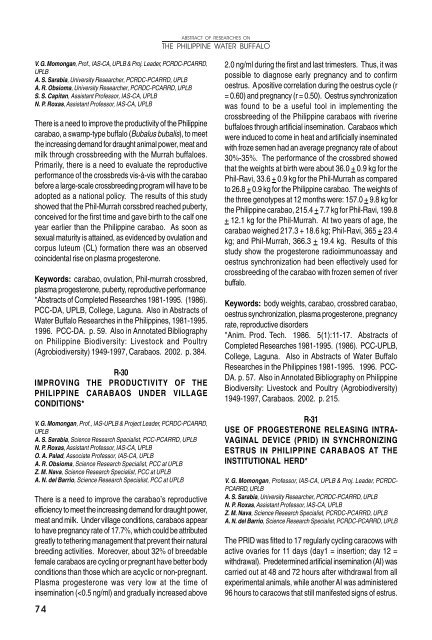THE PHILIPPINE WATER BUFFALO
THE PHILIPPINE WATER BUFFALO
THE PHILIPPINE WATER BUFFALO
Create successful ePaper yourself
Turn your PDF publications into a flip-book with our unique Google optimized e-Paper software.
V. G. Momongan, Prof., IAS-CA, UPLB & Proj. Leader, PCRDC-PCARRD,<br />
UPLB<br />
A. S. Sarabia, University Researcher, PCRDC-PCARRD, UPLB<br />
A. R. Obsioma, University Researcher, PCRDC-PCARRD, UPLB<br />
S. S. Capitan, Assistant Professor, IAS-CA, UPLB<br />
N. P. Roxas, Assistant Professor, IAS-CA, UPLB<br />
There is a need to improve the productivity of the Philippine<br />
carabao, a swamp-type buffalo (Bubalus bubalis), to meet<br />
the increasing demand for draught animal power, meat and<br />
milk through crossbreeding with the Murrah buffaloes.<br />
Primarily, there is a need to evaluate the reproductive<br />
performance of the crossbreds vis-à-vis with the carabao<br />
before a large-scale crossbreeding program will have to be<br />
adopted as a national policy. The results of this study<br />
showed that the Phil-Murrah corssbred reached puberty,<br />
conceived for the first time and gave birth to the calf one<br />
year earlier than the Philippine carabao. As soon as<br />
sexual maturity is attained, as evidenced by ovulation and<br />
corpus luteum (CL) formation there was an observed<br />
coincidental rise on plasma progesterone.<br />
Keywords: carabao, ovulation, Phil-murrah crossbred,<br />
plasma progesterone, puberty, reproductive performance<br />
*Abstracts of Completed Researches 1981-1995. (1986).<br />
PCC-DA, UPLB, College, Laguna. Also in Abstracts of<br />
Water Buffalo Researches in the Philippines, 1981-1995.<br />
1996. PCC-DA. p. 59. Also in Annotated Bibliography<br />
on Philippine Biodiversity: Livestock and Poultry<br />
(Agrobiodiversity) 1949-1997, Carabaos. 2002. p. 384.<br />
R-30<br />
IMPROVING <strong>THE</strong> PRODUCTIVITY OF <strong>THE</strong><br />
<strong>PHILIPPINE</strong> CARABAOS UNDER VILLAGE<br />
CONDITIONS*<br />
V. G. Momongan, Prof., IAS-UPLB & Project Leader, PCRDC-PCARRD,<br />
UPLB<br />
A. S. Sarabia, Science Research Specialist, PCC-PCARRD, UPLB<br />
N. P. Roxas, Assistant Professor, IAS-CA, UPLB<br />
O. A. Palad, Associate Professor, IAS-CA, UPLB<br />
A. R. Obsioma, Science Research Specialist, PCC at UPLB<br />
Z. M. Nava, Science Research Specialist, PCC at UPLB<br />
A. N. del Barrio, Science Research Specialist, PCC at UPLB<br />
There is a need to improve the carabao’s reproductive<br />
efficiency to meet the increasing demand for draught power,<br />
meat and milk. Under village conditions, carabaos appear<br />
to have pregnancy rate of 17.7%, which could be attributed<br />
greatly to tethering management that prevent their natural<br />
breeding activities. Moreover, about 32% of breedable<br />
female carabaos are cycling or pregnant have better body<br />
conditions than those which are acyclic or non-pregnant.<br />
Plasma progesterone was very low at the time of<br />
insemination (


